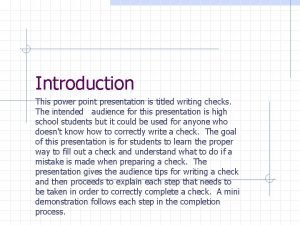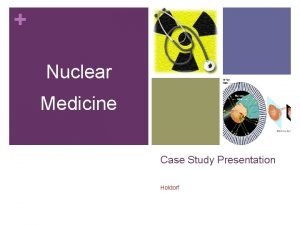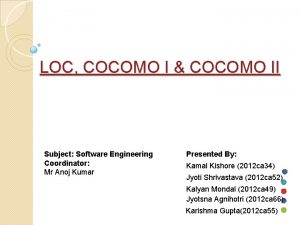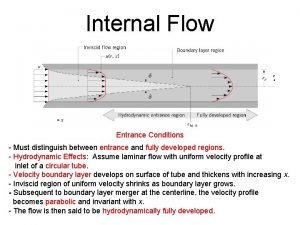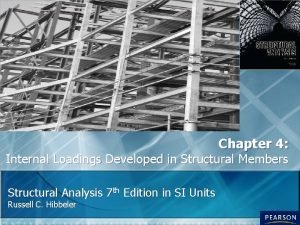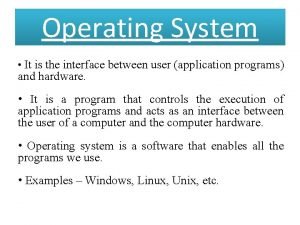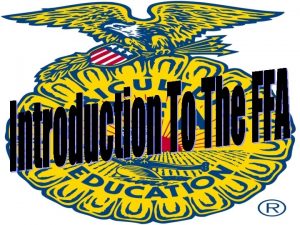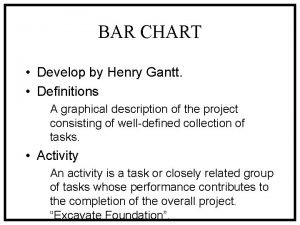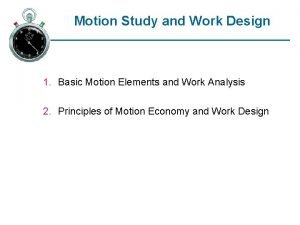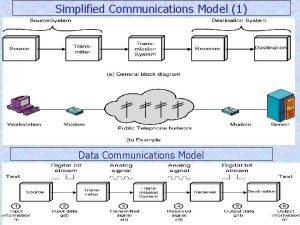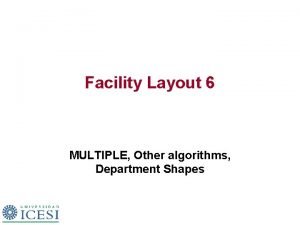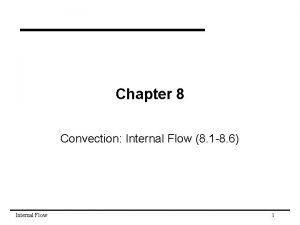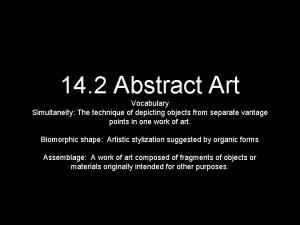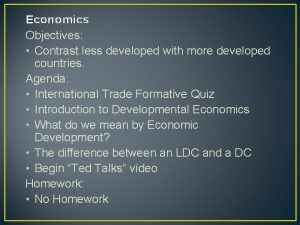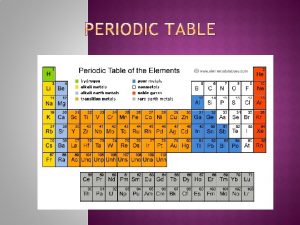1 Introduction This presentation was developed as a



















































































- Slides: 83

1

Introduction This presentation was developed as a teaching aid with the support of the American Institute of Steel Construction. Its objective is to provide technical background and information for bolting and welding. The information provided is based on common design and construction practices for structures of twelve stories or less. The Four Story Building Case study presentations document the construction of a steel frame for an office building. The case study includes photographs that were taken throughout the construction of the structural steel frame including detailing, fabrication, and erection. Project data including plans, schedules, specifications and other details are also included. The case study presentations are available in the Teaching Aids section of University Programs at http: //www. aisc. org/teachingaids. This presentation provides technical information on bolting and welding, as well as the impacts of details and design choices on schedule, cost, sequence and overall project management. The information is presented with concerns of a construction manager or general contractor in mind. 2

What Will You Gain From This Presentation? • General knowledge of structural steel • Insight into issues related to jobsite layout, mobilization, equipment, and coordination for structural steel construction of which construction managers and general contractors should be aware • Familiarity with the necessary coordination between the structural steel contractor and the construction manager and/or general contractor • Knowledge of specific details involved with jobsite layout for structural steel construction • An awareness of jobsite condition requirements defined by the Occupational Safety & Health Administration and by the American Institute of Steel Construction • An understanding of equipment requirements and mobilization processes for structural steel construction 3

Benefits of Structural Steel Some benefits associated with use of structural steel for owners are: • Steel allows for reduced frame construction time and the ability to construct in all seasons • Steel makes large spans and bay sizes possible, providing more flexibility for owners • Steel is easier to modify and reinforce if architectural changes are made to a facility over its life • Steel is lightweight and can reduce foundation costs • Steel is durable, long-lasting and recyclable 4

Unique Aspects of Steel Construction Procurement and management of structural steel is similar to other materials, but there are some unique aspects to steel construction: • Steel is fabricated off-site (above left) • On-site erection is a rapid process (above right) • This gives use of structural steel some scheduling advantages • Coordination of all parties is essential for achieving potential advantages 5

Jobsite Layout Considerations The controlling contractor must consider to support construction operations § Site and building size and configuration § Location of adjacent roads, buildings, and utilities § Soil conditions and excavation requirements § Construction sequence and schedule § Location of underground utilities many factors when laying out a site § § § Equipment requirements Material quantity, storage, and delivery Worker parking Tool and equipment storage Construction operations facilities and trailers Sanitary facilities 6

Stages of Steel Management Design decision to use steel Owner/Arch/Eng Design development Develop contract documents Bidding General contract award Steel contract execution Award lower tier subcontracts This figure shows the stages of steel project management. Order steel Prepare erection and shop drawings Deliver material Shop drawing approval Fabricate steel Deliver fabricated steel Erect fabricated steel and purchased items 7

Early Coordination • While preparing bids, a controlling contractor will define subcontract workscopes and seek prices from subcontractors • Early interaction between a controlling contractor and subcontractors is important • The steel contractor should always be provided with complete contract documents as described in the AISC Code of Standard Practice (2010) 8

Early Coordination • • • The steel contractor, typically the fabricator, (who is not also an erector) will seek lower tier subcontracts for: • Steel erection • Metal deck supply and installation • Shear studs • Special fabrications The controlling contractor will often require that the steel contractor provide input for the preliminary project schedule and jobsite layout. The jobsite layout (above) is key in allowing the steel erector to operate efficiently. 9

Lines of Responsibility Structural engineer Architect Owner General Contractor Steel supplier Steel contractor (fabricator) Steel joist supplier Metal deck installer Steel erector Lower tier subcontractor, fabricator Shear stud installer Metal deck supplier • This figure shows the contractual lines of responsibility for a typical structural steel project. • It should be noted that in some cases the steel contractor will have both fabrication and erection responsibilities. 10

Bid Package • The bid package given to each contractor will usually include information related to: § Workscope § Jobsite conditions and site layout § Space limitations § Allowable temporary facilities • A pre-bid meeting may be held to address questions related to the bid package. • During this pre-bid stage the steel contractor will make a preliminary determination of the crane requirements for the project. 11

Pre-Bid Essentials The steel contractor will need information from the controlling contractor including: • Soil conditions • Site access points • Schedule • Deliveries • Sequencing of other trades • Parking • Crane size and provider • • Placement of crane, job trailer, storage and laydown area Beginning and ending points for erection of steel • Workscope 12

Definition of Workscopes • The controlling contractor defines the subcontract workscopes and solicits subcontract prices during the bidding process. • A workscope definition should include the general conditions or services which the subcontractor must provide and those which the controlling contractor will provide for the subcontractor. • The controlling contractor may wish to subcontract the complete structural steel package to a single steel subcontractor or may choose to divide the steel portion of the project into multiple subcontracts. 13

Site Plan • Site plans usually include existing site conditions, adjacent roads, and topographical information • Above is an example of a site plan that is included in the project drawings • The black area shows the location of the building to be constructed 14

Site Size and Configuration • The jobsite layout and equipment used will be controlled by the site constraints • High on the list of considerations a steel erector will have are: § Crane size and location(s) § Laydown area size § Laydown area location (Mincks and Johnston 2004) 15

Layout for Optimization • The goal of site layout is to optimize erection processes § The number of crane locations is kept to a minimum § Laydown areas should be as close as possible to the structure • This is all dependent on site size and crane specifications • The entire structure shown above was able to be erected with the crawler crane located in one position on the left side of the building 16

Building Footprint On Site The relationship between a new building’s footprint and the size of the site has a significant impact on the erector’s planning and sequencing Space is required for: • Deliveries • Equipment • Construction Materials • Temporary Facilities 17

Laydown Area Location • Laydown areas may move as erection progresses to keep the steel as close as possible to the point of installation (Mincks and Johnston 2004) • At the site shown above the laydown area started within the building footprint and moved to a smaller area outside the building footprint as erection progressed 18

Crane Inside Building Footprint • Additional communication may be required if the steel contractor determines that it is necessary to operate the crane within the footprint of the building to be erected • Installation of some utilities and systems may need to be delayed to avoid damage from the crane 19

Planning the Schedule The overall project schedule and erection sequencing are somewhat dependent on: • Crane locations • Size of the building being constructed Per the Occupational Safety & Health Administration Standard 1926. 753(d) (OSHAb) people, other than the employees engaged in the initial connection of the steel or employees necessary for the hooking or unhooking of the load, are not to be under a hoisted load. • This will limit work of other trades during erection of steel 20

Planning the Schedule • If the size of the building and/or jobsite allows the erection of steel to progress efficiently without hoisting over other trade workers it may be possible for other contractors to work during the erection of steel • At the site shown above a new sewer line, foundation waterproofing, and floor slab reinforcing are being installed as structural steel is being erected 21

Planning the Schedule • Structural steel is a long lead time item that is typically ordered immediately after contract execution • It is important to make thorough plans and scheduling decisions early in the project and stick to them • Once the schedule has been determined it is important that it not be changed • It may not be possible to make late material and/or equipment changes without delays due to limited availability 22

Planning the Schedule • The steel erector and fabricator break down large steel projects into sequences • A given sequence defines a section of the project and the pieces of steel included in that section • The project shown above is divided into six sequences 23

Adjacent Roads • Pedestrian traffic must be kept at a safe distance from the construction site • Fencing and barricades may be necessary to block off all or part of a road during construction operations 24

Site Access Points • The controlling contractor, as stated in the Occupational Safety & Health Administration Standard 1926. 752 (OSHAa), is responsible for providing access points into the construction site • The steel contractor is responsible to communicate any necessary special access requirements to the controlling contractor 25

Worker Parking • Parking for workers is another important consideration in the jobsite layout • Parking availability on and around a jobsite will typically be addressed in the bid package for a project • If parking is available on the jobsite it should be located as close to the work operations as possible without causing interference with work operations (Mincks and Johnston 2004) • Space is available for only a couple of vehicles at the jobsite shown above 26

Worker Parking In some cases parking will not be available on the jobsite • Parking on a street or in an adjacent parking area may need to be arranged § • For the job pictured above, parking spaces along adjacent streets were leased from the city for the duration of the project Some situations may require that a remote parking area be secured and transportation be provided for workers from the parking area to the jobsite 27

Entrance Points for Workers • The controlling contractor usually provides access for workers into the structure of the building (above left) • Access for the erector’s employees from floor to floor is provided by the erector (above right) 28

Entrance Points for Workers The controlling contractor may provide a footbridge over the excavation around a foundation wall (above left) or temporary stairs to upper levels (above right) 29

Soil Conditions and Excavation • Proper jobsite conditions are the responsibility of the controlling contractor (AISC 2010, OSHAa) • It is important to consider how soil conditions and excavation of a site will change over the duration of a project 30

Soil Conditions and Excavation • Bearing capacity of soil in areas where a crane will operate should be verified • Consideration must be given to the proximity of the crane to the edge of an excavation or foundation wall • A geotechnical engineering report furnished by the controlling contractor may be necessary • In the pictures above the crane is positioned very close to an excavation retaining wall 31

Soil Conditions and Excavation • The type of soil on a jobsite and the excavation requirements for a project will dictate if the outside edge of an excavation is to be shored, sloped, or benched • Care should be taken not to remove more soil than necessary if the excavation is sloped or benched • An excavation that is sloped more shallowly than originally specified may: § Create problems with the erector’s predetermined crane locations § Require extra effort for the erection crew to safely access the top of the foundation to erect steel 32

Use of a Man-Lift If a man-lift is to be used on a project, the controlling contractor should take care to ensure that the site and the excavated area around the building footprint are suitable for its operation 33

Overhead Utilities A jobsite should be free from overhead obstructions such as power lines or telephone lines (AISC 2010) 34

Underground Utilities • Precautions may need to be taken if a crane will be operated over certain underground utilities • The controlling contractor should inform the erector of underground utilities located within or near the construction site 35

Underground Utilities • In this case, a fire hydrant (right) which was not to be removed happened to be located in the middle of the desired crane location • The stone base and timber mat provide just enough clearance for operation (above) 36

Contract Awarded Upon contract award, the steel contractor will immediately begin a number of tasks: • Definition of detailed workscopes, pricing, and schedules • Steel is ordered from the steel mill • Anchor rod setting plans, shop drawings (example above), and erection drawings are prepared for approval • Jobsite layout is finalized 37

Fabrication • Shop drawings may be prepared and submitted to the controlling contractor in phases to expedite the fabrication process • Fabrication begins after the mill steel is received and the first batch of shop drawings are approved • Steel will be fabricated in sequences as determined during scheduling • Once fabricated, the steel is organized and awaits delivery to the jobsite 38

Finalization of Jobsite Layout • The finalized jobsite layout will include laydown area details and crane locations • On the drawing above the crane locations have been determined by the erector • The yellow bars represent locations of the crawler crane tracks • The red lines represent the critical lifts to be performed from each location § A lift is critical if it is in excess of 75% of the crane capacity 39

Jobsite Condition Requirements • Per the Occupational Safety & Health Administration Standard 1926. 752 and the AISC Code of Standard Practice Section 7. 2, the Owner or Owner’s Designated Representative for Construction shall provide and maintain certain jobsite conditions (AISC 2010, OSHAa) • The following slides describe the required provisions 40

Adequate Access Roads Adequate access roads into and through the site for the safe delivery and movement of: • Derricks • Trucks • Cranes • Other necessary equipment 41

Adequate Access Roads • Adequate access roads must be provided into and through a site for safe delivery and movement of materials • There must be means and methods for pedestrian and vehicular control 42

Space On the Jobsite Space on the jobsite that is: • Firm • Properly graded • Properly drained 43

Space On the Jobsite Space on the jobsite that is: • Readily accessible to the work • Sufficient for safe operation of equipment 44

Space On the Jobsite Space on the jobsite that is: • Adequate for safe and secure storage of materials • Enables the Fabricator and Erector to operate at maximum practical speed à Unless the structure occupies the full available jobsite 45

Jobsite Condition Requirements The provisions described on the previous slides are to be met by the Owner or the Owner’s Designated Representative for Construction 46

Operations Facilities • A steel contractor will usually need to have a job trailer or other portable dry space on the site • If a job trailer cannot be placed on the site due to limited space, the controlling contractor should provide a dry, secure space from which the steel contractor can operate • Labor rules usually require the availability of a dry shack for workers to use for breaks and lunches (Mincks and Johnston, 2004) 47

Operations Facilities • The steel contractor will usually have a limited number of workers on the jobsite at a time, so space requirements for a job trailer are minimal • In the case shown above, a large transport van (center back) was used as the dry facility for the workers • Provisions for a job trailer or dry shack, such as electricity and water, will usually be the responsibility of the steel contractor • The controlling contractor typically provides sanitary facilities on a jobsite (Mincks and Johnston 2004) 48

Layout Responsibilities • The controlling contractor is responsible for precise location of building lines and benchmarks on a jobsite and must provide the erector with a plan showing such information • It is the responsibility of subcontractors to layout their work and inspect any construction in-place before beginning their work • The steel fabricator supplies the controlling contractor with anchor rod setting plans for setting the structural steel anchor rods (AISC 2010) 49

Layout Responsibilities • Prior to mobilization, the steel contractor should field-check the placement and elevations of the anchor rods • Additional costs and delays may result if anchor rods are found to be improperly placed after mobilization 50

Modifications to Anchor Rods • Any discrepancies from the setting plans or necessary anchor rod repairs should be brought to the attention of the controlling contractor • Per the Occupational Safety & Health Administration Standard 1926. 755(b) (OSHAc): § Anchor rods (anchor bolts) shall not be repaired, replaced or field-modified without the approval of the project structural engineer of record. § “Prior to the erection of a column, the controlling contractor shall provide written notification to the steel erector if there has been any repair, replacement or modification of the anchor rods (anchor bolts) of that column. ” 51

Erection and Installation Equipment • The erector will typically provide most, if not all, of the erection equipment needed • Typical equipment used for structural steel erection includes: § Crane(s) § Generators § Air Compressors § Man-lifts § Welding Equipment § Hand Tools 52

Crane Types • There are several crane types used in construction • Construction cranes are usually identified as either mobile cranes (above left), tower cranes (above right), or derricks • Mobile cranes are traditionally preferred by contractors in North America • Tower cranes are typically only used for high-rise construction or on jobsites where space is restricted • A derrick is a hoisting mechanism with a hoisting engine that is not a part of the hoisting mechanism (Shapiro et al. 2000, Peurifoy and Schexnayder 2006) 53

Mobile Cranes • A crane that can move around a jobsite under its own power is a mobile crane • Common mobile crane types are: § Telescoping-boom truck mounted (above right) § Crawler § Rough-terrain (above left) § § All-terrain Lattice-boom truck mounted (Shapiro et al. 2000, Peurifoy and Schexnayder 2006) 54

Crawler Cranes • Crawler cranes get their name from the continuous, parallel crawler tracks that are used to move them around a construction site § • A large ground contact area is provided by the crawler tracks The superstructure on a crawler crane is fully revolving (Peurifoy and Schexnayder 2006) 55

Crawler Cranes • Prior to lifting a load, the crane must be leveled and the soil bearing capacity considered • It is common to position the crane on timber mats to further distribute the load (Peurifoy and Schexnayder 2006) 56

Crawler Cranes • Crawler cranes must be transported by truck, rail, or barge • Time and cost to load, haul, assemble (or mobilize), operate, disassemble, reload, and haul (or demobilize) need to be considered • Some of the largest crawler cranes need up to 15 trucks to be transported (Peurifoy and Schexnayder 2006) 57

Anatomy of a Crawler Crane Luffing Jib Top Luffing Jib Boom Luffing Jib Butt Luffing Jib Struts Boom Top Hook Block “Headache Ball” Boom Butt 58

Anatomy of a Crawler Crane Gantry Crawler Car Body Operator’s Cab Mast Engine, Drums, and Boom Hoist (hidden) Counterweights 59

Rough-terrain Cranes • Rough-terrain cranes are mounted on a two-axle chassis with the operator’s cab located either on the upper works or the chassis • Large wheels and a short wheel base make these cranes very maneuverable on the construction site • Outrigger beams are used to stabilize the crane during use • Slopes of 50 to 70% can be traversed by a rough-terrain crane (Shapiro et al. 2000, Peurifoy and Schexnayder 2006) 60

Anatomy of a Rough-terrain Crane Boom Head Telescopic Boom Hook Block Operator’s Cab Optional Jib Lifting Ram Counterweight Outrigger Oversized Wheels 61

Mobilizing the Crane • Mobilization involves transporting the crane to the jobsite and preparing the crane for use • Mobilizing rough-terrain, all-terrain, and telescoping-boom truck mounted cranes is a relatively fast process • Telescoping-boom cranes can usually be positioned and ready to hoist steel in under thirty minutes 62

Mobilizing the Crane • Most rough-terrain cranes (above left) can travel on surface streets, but have a maximum speed of about 30 mph • For long moves between projects, rough-terrain cranes should be transported on low-bed trailers • All-terrain and truck mounted cranes (above right) are designed to be driven to the jobsite on surface streets (Peurifoy and Schexnayder 2006) 63

Mobilizing a Crawler Crane • Assembling the many parts of a crawler crane may take several days • Some crawler cranes can assemble themselves, while others require the use of another crane for assembly • At this site, a rough-terrain crane was used to assemble the crawler crane 64

Mobilizing a Crawler Crane • The counterweights are put into place (above left) • The pieces of the jib wait to be assembled (above right) 65

Mobilizing a Crawler Crane This photo shows line being run through the boom and jib 66

Delivery of Steel • Structural steel erection requires the delivery of steel by the truckload • It is common practice to unload steel from a truck into a laydown area • A crew will then shakeout the steel into the order that it will be erected • There may be several truck loads of steel in the laydown area at one time to prevent the erection process from being interrupted • The size and location of the laydown area are important factors to be considered with structural steel erection 67

Delivery Access • A flagman may be necessary to direct traffic around the construction site entrance point and unloading zone during delivery times • Signs and gates should be used to ensure that pedestrians cannot accidentally enter the construction site 68

Seasonal Load Limits Some northern parts of the country will have seasonal load limits on certain roads during late winter and early spring months • Restrictions are implemented during the time when the ground is thawing after the cold winter months § This is done to reduce the wear on some roadways during the thaw cycle • It may not be possible to deliver the required crane to a jobsite during this period • Truck delivery capacities of structural steel may be reduced by 35 percent 69

Materials On Site • Material delivery, quantity, and storage requirements will vary from project to project • There are, however, some common requirements for structural steel construction 70

Laydown Area • The laydown area needs to be flat, firm, and well drained • Cribbing is usually placed under the structural steel members for ease of rigging and to keep the steel clean • Steel erectors generally prefer to have a minimum of two truckloads of steel in the laydown area to ensure that erection can continue without interruption • A typical structural steel project will require a laydown area that is between 50 feet by 50 feet and 100 feet by 100 feet § This area allows the steel members to be appropriately spaced and organized for efficient erection 71

Laydown Area Some projects, where large, built-up trusses are used, will require a much larger laydown area for fabrication on the jobsite 72

Limited Space for Deliveries • For projects where delivery space is limited, extra coordination will be required to accomplish quick unloading • Requirements might include: § An off-site staging area for delivery trucks to wait until directed to proceed to the site or for trailers to be dropped until they are needed § Radio communication between delivery drivers and the jobsite § A flagman to direct traffic around the delivery point 73

Erecting Structural Steel • Per the AISC Code of Standard Practice (2010), “The Erector shall be responsible for the means, methods and safety of erection of the Structural Steel frame. ” • Multiple lift rigging, as seen in the picture above, is the process where several pieces of steel are lifted simultaneously to speed erection by reducing the total number of lifts required for the frame • Refer to the AISC Digital Library Four Story Office Building Case Study presentations about Structural Steel Erection for more details related to the erection of structural steel. There is a video “Structural Steel Erection” on the Teaching Aids website (www. aisc. org/teachingaids) 74

Adjacent Property If the size of the site and the relationship of the building to the site and surrounding properties require that loads be lifted over adjacent property, then certain precautions may need to be taken: • Vacancy of the affected adjacent property • Additional barricading to ensure a safe construction zone • Extra care to minimize the risk of damage to any adjacent property 75

Structural Steel Erection Complete As stated in the Code of Standard Practice (AISC 2010): • The controlling contractor shall accept the structural steel for plumbness, elevation, and alignment prior to the placement or installation of other materials • “Upon the completion of erection and before final acceptance, the Erector shall remove all of the Erector’s falsework, rubbish and temporary buildings. ” 76

Custody Of Fall Protection Per the Occupational Safety & Health Administration Standard 1926. 760(e) (OSHAd): “Fall protection provided by the steel erector shall remain in the area where steel erection activity has been completed, to be used by other trades, only if the controlling contractor or its authorized representative: • Has directed the steel erector to leave the fall protection in place; and • Has inspected and accepted control and responsibility of the fall protection prior to authorizing persons other than steel erectors to work in the area. ” 77

Demobilizing the Crane Demobilization may take as much time as mobilization • Cranes with telescoping booms may be demobilized in a matter of minutes • Demobilization of a lattice boom crane may take several days 78

Demobilizing a Crawler Crane This photo shows the main boom being disassembled and loaded onto a truck for transport 79

Demobilizing a Crawler Crane • Crawler crane with the main boom and most of the counterweights removed (above left) • The boom butt has been removed (above right) 80

Demobilizing a Crawler Crane The base machine of this crawler crane has self-contained jacks (above left) that allow a low-bed trailer to be backed under it for transport 81

Structural Steel: The Material of Choice 82

References AISC. (2010). Code of Standard Practice for Steel Buildings and Bridges. American Institute of Steel Construction, Inc. Chicago, IL. Mincks, W. R. , and Johnston, H. (2004). Construction Jobsite Management. Delmar Learning, Clifton Park, NY. Occupational Safety & Health Administration, (OSHAa). (2001). Standard Number 1926. 752. “Site layout, site-specific erection plan and construction sequence. ” Washington, DC. Occupational Safety & Health Administration, (OSHAb). (2010). Standard Number 1926. 753. “Hoisting and Rigging. ” Washington, DC. Occupational Safety & Health Administration, (OSHAc). (2001). Standard Number 1926. 755. “Column Anchorage. ” Washington, DC. Occupational Safety & Health Administration, (OSHAd). (2001). Standard Number 1926. 760. “Fall Protection. ” Washington, DC. Peurifoy, R. L. , and Schexnayder, C. J. (2006). Construction Planning, Equipment, and Methods. Mc. Graw-Hill Companies, Inc. New York, NY. Shapiro, H. I. , Shapiro, J. P. , and Shapiro, L. K. (2000). Cranes and Derricks. Mc. Graw-Hill Companies, Inc. New York, NY. 83
 Smallest anteroposterior diameter of the pelvic inlet
Smallest anteroposterior diameter of the pelvic inlet Leopold's maneuver
Leopold's maneuver Purpose of presentation
Purpose of presentation Presentation introduction example
Presentation introduction example Presentation introduction
Presentation introduction Introduction of seminar presentation
Introduction of seminar presentation Example oral presentation in english
Example oral presentation in english Titles for mental health presentations
Titles for mental health presentations Abcd opening presentation
Abcd opening presentation Presentation parts
Presentation parts Case presentation introduction
Case presentation introduction Good morning assalamualaikum
Good morning assalamualaikum Introduction about food presentation
Introduction about food presentation Presentation introduction in english
Presentation introduction in english Rasmussen apa format
Rasmussen apa format Hospital introduction presentation
Hospital introduction presentation Teksun introduction presentation
Teksun introduction presentation Bffc11
Bffc11 Developed country
Developed country What is the expected life of the nozzles used in wjm
What is the expected life of the nozzles used in wjm Unix was originally developed in
Unix was originally developed in Comparative education in developed countries
Comparative education in developed countries Hirschi's social bond theory
Hirschi's social bond theory Advantages and disadvantages of circuit training
Advantages and disadvantages of circuit training Electric force
Electric force Ed wagner chronic care model
Ed wagner chronic care model Developed country
Developed country Unconditioned vs conditioned stimulus
Unconditioned vs conditioned stimulus Mdc ldc
Mdc ldc Cocomo i
Cocomo i Fully developed flow
Fully developed flow Html developed by
Html developed by Turbulent spots
Turbulent spots Expectancy value theory of motivation
Expectancy value theory of motivation Least developed country
Least developed country Agriculture in sangam age
Agriculture in sangam age Explain briefly the real self and ideal self by carl rogers
Explain briefly the real self and ideal self by carl rogers Designed & developed by gstn
Designed & developed by gstn Who developed control chart
Who developed control chart Intermediate cocomo model example
Intermediate cocomo model example Internal loadings
Internal loadings Auditing user developed applications
Auditing user developed applications Posix standards
Posix standards Basic structure of a computer
Basic structure of a computer Goal of johari window
Goal of johari window Humanistic perspective of personality
Humanistic perspective of personality Ces production function is developed by
Ces production function is developed by Balanced scorecard of starbucks
Balanced scorecard of starbucks Which operating system is a multiuser os developed in 1969
Which operating system is a multiuser os developed in 1969 Anne boykin and savina schoenhofer theory
Anne boykin and savina schoenhofer theory Abraham maslow picture
Abraham maslow picture Law of friction
Law of friction Incas assessments
Incas assessments Abraham maslow developed his hierarchy of needs
Abraham maslow developed his hierarchy of needs Think before you leap
Think before you leap W.d. pattison
W.d. pattison Which act first developed courses in vocational agriculture
Which act first developed courses in vocational agriculture Extended metaphor definition
Extended metaphor definition Designed & developed by gstn
Designed & developed by gstn Bar chart in project management
Bar chart in project management Quantum mechanical model scientist
Quantum mechanical model scientist Therblig
Therblig An idealized image that we have developed over time
An idealized image that we have developed over time Great contributors in the development of gymnastics
Great contributors in the development of gymnastics Why was the gps network originally developed
Why was the gps network originally developed Ccf was developed by unesco
Ccf was developed by unesco The arbitrage pricing theory was developed by
The arbitrage pricing theory was developed by Managers and management chapter 1
Managers and management chapter 1 Who developed the assure model
Who developed the assure model Lc in arabic numerals
Lc in arabic numerals Well developed paragraph format
Well developed paragraph format What is kitchen brigade
What is kitchen brigade The gift of the magi setting
The gift of the magi setting Less developed countries
Less developed countries Model of data communication
Model of data communication What is the sunrise model
What is the sunrise model Multifloor plant layout evaluation
Multifloor plant layout evaluation Is a developing country
Is a developing country Sunken screen pan evaporimeter
Sunken screen pan evaporimeter Alchemists developed processes for separating
Alchemists developed processes for separating Internal flow examples
Internal flow examples Is cyprus a developed country
Is cyprus a developed country Register disbursement schemes
Register disbursement schemes Abstract art vocabulary
Abstract art vocabulary




